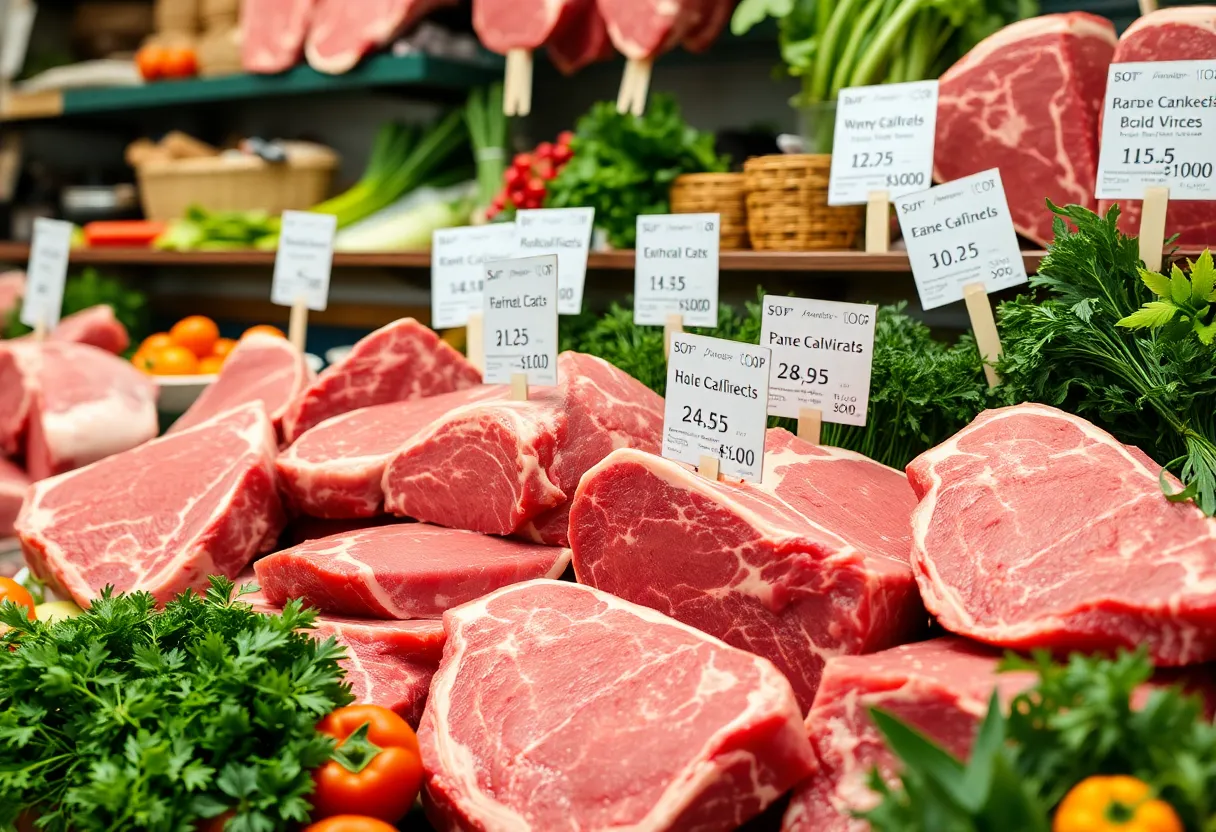News Summary
California is seeing a significant rise in beef prices due to supply shortages and increased demand. Ground beef prices have risen to $6.12 per pound, while steak prices average $11.49 per pound. Ranchers capitalize on higher selling prices, but vendors struggle to maintain stock levels amidst decreasing cattle numbers and rising production costs. The beef market is at a crossroads as factors like drought, feed costs, and potential tariffs on imported beef threaten to keep prices elevated.
California is experiencing a significant rise in beef prices, driven by supply shortages and increased demand. Over the past year, prices for beef and steak have steadily escalated, with ground beef prices now averaging $6.12 per pound—up 12% from the previous year—and uncooked beef steaks reaching an average of $11.49 per pound, reflecting an 8% increase. As the grilling season heats up, consumers face notable challenges as vendors struggle to keep their shelves stocked amid dwindling inventories and unpredictable costs.
Ranchers across the state are capitalizing on higher selling prices, benefiting from historically good profit margins due to the increased costs associated with production and herd management. Although ranchers are enjoying favorable conditions, vendors, particularly in Northern California, report major difficulties in maintaining adequate stock levels. Some vendors receive daily shipments that do not fully satisfy their orders, leading to shortages in supply.
The current state of the beef market can be attributed to a reduction in the U.S. cattle herd, which is now at its lowest since 1951. This decline has been influenced by several factors, including severe drought conditions, rising feed costs, and elevated slaughter rates of female cattle. As a result of the decreased cattle numbers, cow production has reached its lowest levels in the past 60 to 70 years, leading to significant supply issues that have prompted ranchers to raise prices on beef products.
Recent data indicates that demand for ground beef has increased by approximately 12% compared to last year, while steak prices have also risen significantly. This trend has led consumers to adapt their purchasing habits, turning to alternative meats such as pork, chicken, and turkey as beef prices continue to spike. Furthermore, prices for beef organs, like livers and hearts, have risen to levels that now rival those of ground beef and steak.
The vendor side of the industry is grappling with inconsistent prices and procurement challenges. Due to fluctuating operating costs, vendors are regularly adjusting their prices weekly. For instance, one vendor noted the pressure from increasing costs and limited availability, prompting them to raise their prices frequently to keep pace with market demand and supply challenges.
While ranchers have reported impressive profit margins this year, the situation remains precarious. Even with potential improvements in weather conditions leading to better pasture and feed availability, rebuilding herds can take considerable time, and ranchers may hesitate to expand herds quickly. Additionally, fresh challenges appear on the horizon as the emergence of the New World screwworm fly in Mexico has adversely affected cattle imports, tightening the supply further.
Looking ahead, potential tariffs on imported beef could also exacerbate the rising prices, suggesting that costs for meatpackers—and ultimately consumers—might face significant increases. Despite these challenges, the unwavering consumer demand for beef, especially in the peak grilling season, indicates that prices are likely to remain elevated in the foreseeable future. Overall, California’s beef market stands at a crossroads, with evolving supply dynamics, consumer habits, and environmental conditions paving the way for an uncertain future.
Deeper Dive: News & Info About This Topic
- KCRA: Rising Beef Prices in California
- NerdWallet: Why is Beef So Expensive?
- NBC DFW: Beef Prices Have Soared in the U.S.
- Wikipedia: Beef
- Google Search: California Beef Prices

Author: STAFF HERE MISSION VIEJO WRITER
The MISSION VIEJO STAFF WRITER represents the experienced team at HEREMissionViejo.com, your go-to source for actionable local news and information in Mission Viejo, Orange County, and beyond. Specializing in "news you can use," we cover essential topics like product reviews for personal and business needs, local business directories, politics, real estate trends, neighborhood insights, and state news affecting the area—with deep expertise drawn from years of dedicated reporting and strong community input, including local press releases and business updates. We deliver top reporting on high-value events such as Oso Fit 5K Fun Run and Community Health Fair, Walk Against Drugs & Community Fair, and National Night Out. Our coverage extends to key organizations like the Mission Viejo Chamber of Commerce and Providence Mission Hospital Mission Viejo, plus leading businesses in retail and education that power the local economy such as The Shops at Mission Viejo, Capistrano Unified School District, and Amazon Delivery Station. As part of the broader HERE network, including HEREAnaheim.com, HEREBeverlyHills.com, HERECostaMesa.com, HERECoronado.com, HEREHollywood.com, HEREHuntingtonBeach.com, HERELongBeach.com, HERELosAngeles.com, HERESanDiego.com, and HERESantaAna.com, we provide comprehensive, credible insights into California's dynamic landscape.


